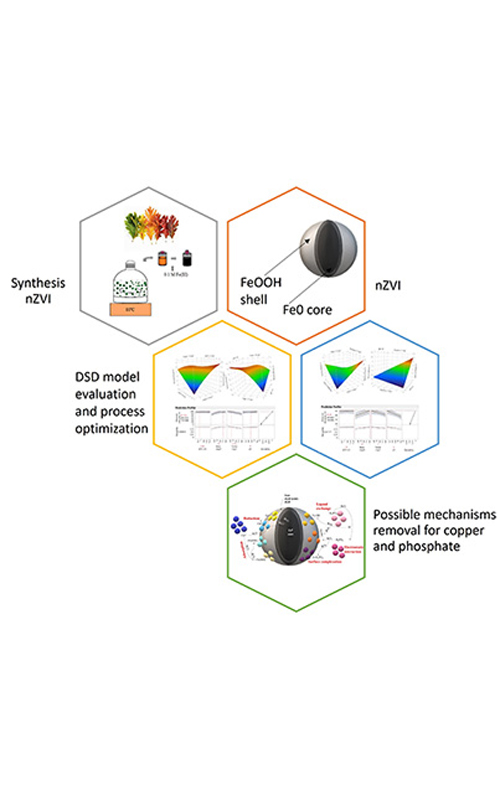Cost-effective method of simultaneous removal of copper and phosphate on environmentally friendly nanomaterial Scientific paper
Main Article Content
Abstract
Environmentally friendly and economically viable methods are essential in the selection of materials and techniques for the synthesis of nano-zero-valent iron. Plants, with their high polyphenol content and antioxidant capacity, have found application in eco-friendly synthesis processes. The definitive screening design (DSD) monitored four key process parameters for the concurrent removal of copper and phosphate: copper concentration (ranging from 1 to 9 mg L-1), phosphate concentration (ranging from 1 to 9 mg L-1), initial pH values (ranging from 2 to 10), and the dosage of nano-zero-valent iron (ranging from 2 to 16 mL). The analysis results provide valuable insights into the significant individual factors influencing the process, along with the potential for their interactions. The model also proposes process optimization to attain maximum removal efficiency, and subsequent verification confirmed its superiority among the alternatives. Mechanisms such as sorption, reduction, complexation, electrostatic attraction, and ligand exchange play pivotal roles in the effective removal of copper and phosphate using nano-zero-valent iron. In summary, this research yields several benefits: the utilization of environmentally sustainable materials, a substantial reduction in experimental complexity, coupled with the ease of the entire procedure, simultaneous and highly efficient copper and phosphate removal, favorable pH levels and, notably, no requirement for additional treatment.
Downloads
Metrics
Article Details

This work is licensed under a Creative Commons Attribution 4.0 International License.

Authors retain copyright and grant the journal right of first publication with the work simultaneously licensed under a Creative Commons Attribution license 4.0 that allows others to share the work with an acknowledgement of the work's authorship and initial publication in this journal.
Funding data
-
Ministarstvo Prosvete, Nauke i Tehnološkog Razvoja
Grant numbers 451-03-47/2023-01/200125 -
Ministarstvo Prosvete, Nauke i Tehnološkog Razvoja
Grant numbers 451-03-68/2020-14/200125 -
Ministarstvo Prosvete, Nauke i Tehnološkog Razvoja
Grant numbers 451-03-9/2021-14/200125 -
Ministarstvo Prosvete, Nauke i Tehnološkog Razvoja
Grant numbers 451-03-68/2022-14/200125 -
Science Fund of the Republic of Serbia
Grant numbers PROMIS 6066881
References
M. M. Tarekegn, A. M. Hiruy, A. H. Dekebo, RSC Adv. 11 (2021) 18539 (https://doi.org/10.1039/d1ra01427g)
S. Poguberović, PhD Thesis, University in Novi Sad, 2017 (https://nardus.mpn.gov.rs/handle/123456789/6294) (in Serbian)
A. M. Abdelfatah, M. Fawzy, A. S. Eltaweil, M. E. El-Khouly, ACS Omega I6 (2021) 25397 (https://doi.org/10.1021/acsomega.1c03355)
B. Sutcliffe, A. A. Chariton, A. J. Harford, G.C. Hose, P. Greenfield,D. J. Midgley, I. T. Paulsen, Ecology 34 (2018) 28 (https://doi.org/10.1016/j.funeco.2018.03.003)
J. Yang, Y. Xie, K. Jeppe, S. Long, V. Pettigrove, X. Zhang, Environ. Toxicol. Chem. 37 (2017) 599 (https://doi.org/doi:10.1002/etc.3980)
Y. H. Zhang, F. Q. Liu, C. Q. Zhu, X. P. Zhang, M. M. Wei, F. H. Wang, C. Ling, A. M. Li, J. Hazard. Mater 329 (2017) 290 (https://doi.org/10.1016/j.jhazmat.2017.01.054)
O. Eljamal, I. P. Thompson, I. Maamoun, T. Shubair, E. Kareman, K. Lueangwattanapong, Y. Sugihara, J. Mol. Liq. 299 (2020) 112144 (https://doi.org/10.1016/j.molliq.2019.112144)
S. Li, W. Wang, F. Liang, W. X. Zhang, J. Hazard. Mater. 16 (2017) 163 (https://doi.org/10.1016/j.jhazmat.2016.01.032)
J. Suazo-Hernández, P. Sepúlveda, L. Cáceres-Jensen, J. Castro-Rojas, P. Poblete-Grant, N. Bolan, M. L. Mora, Nanomaterials 13 (2023) 399 (https://doi.org/10.3390/nano13030399)
V. Gvoić, M. Prica, M. Turk Sekulić, S. Pap, O. Paunović, A. Kulić Mandić, M. Bečelić-
-Tomin, Dj. Vukelić, Dj. Kerkez, Environ. Technol. (2022) (https://doi.org/10.1080/09593330.2022.2154082)
H. Boulika, M. El Hajam, M. H. Nabih, I. Riffi Karim, N. Idrissi Kandri, A. Zerouale, Mater. Today: Proc. 72 (2023) 336 (https://doi.org/10.1016/j.matpr.2022.07.358)
J. Jokić Govedarica, D. Tomašević Pilipović, V. Gvoić, Đ. Kerkez, A. Leovac Maćerak, N. Slijepčević, M. Bečelić-Tomin, Water Sanit. Technol. 2 (2022) 13 (502.51:504.5:546.48 546.72:502.174)
B. Jones, C. J. Nachtsheim, J. Qual. Technol. 45 (2017) 121 (https://doi.org/10.1080/00224065.2013.11917921)
D. Movrin, O. Luzanin, V. Guduric, Rapid Prototyping J. 25 (2018) 653 (https://doi.org/10.1108/RPJ-07-2018-0177)
A. Šućurović, PhD Thesis, University in Novi Sad, 2017 (https://nardus.mpn.gov.rs/handle/123456789/8836) (in Serbian)
T. Tosco, P. M. Papini, C. V. Cruz, R. Sethi, J. Clean. Prod. 77 (2014) 10 (https://doi.org/10.1016/j.jclepro.2013.12.026)
T. Pasinszki, M. Krebsz, Nanomaterials 10 (2020) 917 (https://doi.org/10.3390/nano10050917)
A. O. Dada, F. A. Adekola, E. O. Odebunmi, A. S. Ogunlaja, O. S. Bello, Sci. Rep. 11 (2021) 16454 (https://doi.org/10.1038/s41598-021-95090-8)
S. Azordeh Molkabadi, M. Asadi, Pollution 9 (2023) 1074 (https://doi.org/10.22059/poll.2023.349294.1640)
A. Leovac Maćerak, A. Kulić Mandić, V. Pešić, D. Tomašević Pilipović, M. Bečelić-
-Tomin, Đ. Kerkez, Molecules 28 (2023) 1425 (https://doi.org/10.3390/molecules28031425).





